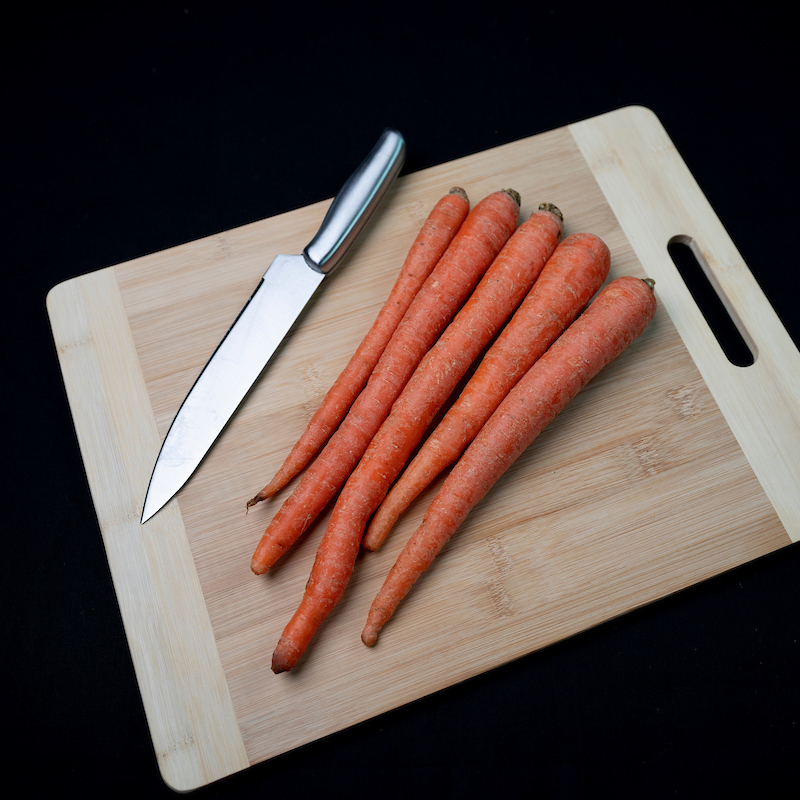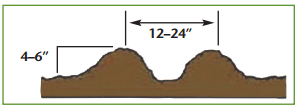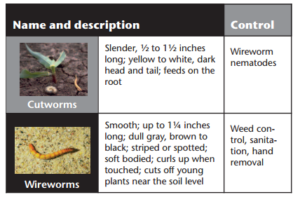Carrots
By: Joseph Masabni

Carrots are an excellent source of vitamin A and add color to a meal. They can be served cooked or raw, by themselves or in salads or other dishes. For home planting, 5 to 10 feet of row per person should supply enough fresh carrots for table use. One foot of row will yield about 1 pound of carrots.
Site selection
Carrots do best in loose, sandy loam soils that are well drained. In heavy soils, they mature more slowly, and the roots are often rough and unattractive. They will grow in some shade and do well in small gardens and flower beds.
Soil preparation
Remove all rocks, trash and large pieces of plant material from the soil surface. Small, fine pieces of plant material can be turned under to enrich the soil.
Spade the soil 8 to 12 inches deep. Turn it completely over so all plant material is covered. Smooth the soil and work it up into beds (Fig. 1). Beds allow good movement of air and water through the soil.

Place the carrot rows 1 to 2 feet apart. If ridges are farther apart, plant two rows of carrots on each ridge (Fig. 2).

Varieties
Carrot varieties that do best in Texas include Danvers 126, Danvers Half Long, Imperator 58, Nantes, Nantes Half Long, Red Core Chantenay, Royal Chantenay, Scarlet Nantes, and Sugar Snax.
Planting
Begin planting carrots as soon as the soil can be worked in the spring. In South Texas, plant carrots any time from July through February. In many South Texas areas, carrots can be grown all winter. For a fall crop in other areas, plant them in August.

Using a hoe handle or stick, make one or two rows ½ inch deep on top of each prepared ridge. Scatter 18 to 20 seeds per foot in the row. Because carrot seeds require 14 to 21 days to sprout, many gardeners mix a few radish seeds, which sprout quickly, with carrot seeds to mark the row. Cover the seeds lightly (Fig. 3).
Carrots grow best in cool temperatures of early spring and late fall. Night temperatures of 55 degrees F and day temperatures of 75 degrees F are ideal for carrots. High temperatures cause poorly colored, low-quality carrots.
Fertilizing
Before planting carrots, scatter on the soil 1 cup of a complete fertilizer such as 10-10-10 for each 10 feet of row to be planted. Use a rake to mix the fertilizer into the soil to a depth of 3 to 4 inches.
Once the plants emerge, scatter 2 tablespoons of fertilizer per 10 feet of row beside the plants when the tops are about 4 inches high. Fertilize again when tops are 6 to 8 inches high if the tops become pale.
Watering
Water the plants as required to keep the soil moist to about 3 inches deep.
Care during the season

When the carrot tops are 4 inches high, thin the plants to 2 inches apart. Some carrots will be large enough to eat. Thin the carrots to 4 inches apart as they continue to grow. Overcrowding and rocky soils result in poor quality roots (Fig. 4).
If radishes were mixed with the carrots, pull and eat them as they mature.
To prevent the soil from crusting, scratch the soil lightly around the plants and sprinkle the row with water often to prevent crusting, or cover the seeds with vermiculite or sand. This is especially helpful for crops planted in the hot summer.
Weeds
Keep the carrots in your garden free of weeds, especially when they are small. Weeds will take nutrients and moisture from the soil and reduce your carrot yields.
Insects

Many insecticides are available at garden centers for homeowner use. Sevin® is a synthetic insecticide; organic options include Bt-based insecticides and sulfur. Sulfur also has fungicidal properties and can help control many diseases.
Before using a pesticide, read the label and always follow cautions, warnings, and directions.
Diseases
If leaf spots appear on the plants, dust them with an approved fungicide. Remove from the garden any carrot plant that becomes yellow and stunted.
If the roots have knots on them, your soil may have nematodes. Neem oil, sulfur, and other fungicides can be used. Always follow the label directions.
Harvesting
Carrots should be ready for harvest 70 to 80 days after planting. Pull them from the soil when the roots are 1 to 1½ inches in diameter. To avoid breaking the carrot while pulling, loosen the soil around the carrot with a spade.
To prevent the roots from wilting after harvest, remove the carrot tops and place them in the compost pile. Pull unused carrots and place them in a compost pile or spade them into the soil.
Storage
Wash the carrots and store them in the bottom of the refrigerator. Carrots will keep several weeks if you place them in a plastic bag to increase humidity and store them at a temperature near 32 degrees F.
Download a printer-friendly version of this page: Carrots
Download this publication in Spanish: Cómo cultivar zanahorias
Download the Growing Carrots Guide: Growing Carrots Guide
